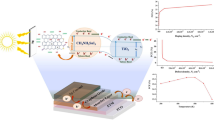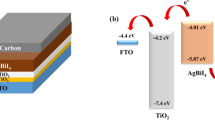Abstract
Replacement of commonly gold (Au) with other non-precious metals is a crucial step for low-cost perovskite solar cells (PSCs). However, severe performance degradations always occurred when we get rid of the Au electrode, mainly because of the deteriorated hole-transporting properties. Here, we reported that the efficiency of the PSCs featuring silver (Ag) back-electrode can be increased from 17.02 to 18.62% after introducing a thin molybdenum trioxide (MoO3) film in between the Spiro-OMeTAD and the Ag electrode. Characterizations from impedance spectrum and dark current density showed that the addition of MoO3 can effectively reduce the series resistance and reverse saturation current density of the devices, thereby leading to improved fill factor and open-circuit voltage. The enhancements in hole transport and extraction at the interface were further confirmed by the external quantum efficiency and photoluminescence tests. Our results suggested that silver electrode with MoO3 is a promising design strategy for efficient and cost-effective PSCs.





Similar content being viewed by others
References
Kazim S, Nazeeruddin MK, Gratzel M, Ahmad S (2014) Perovskite as light harvester: a game changer in photovoltaics. Angew Chem Int Ed Engl 53:2812–2824
Manser JS, Kamat PV (2014) Band filling with free charge carriers in organometal halide perovskites. Nat Photonics 8:737–743
Miyata A, Mitioglu A, Plochocka P et al (2015) Direct measurement of the exciton binding energy and effective masses for charge carriers in an organic–inorganic tri-halide perovskite. Nat Phys 11:582–587
Yang WS, Park BW, Jung EH et al (2017) Iodide management in formamidinium-lead-halide-based perovskite layers for efficient solar cells. Science 356:1376–1379
Domanski K, Correa-Baena JP, Mine N et al (2016) Not all that glitters is gold: metal-migration-induced degradation in perovskite solar cells. ACS Nano 10:6306–6314
Wei D, Wang T, Ji J et al (2016) Photo-induced degradation of lead halide perovskite solar cells caused by the hole transport layer/metal electrode interface. J Mater Chem A 4:1991–1998
Lei L, Zhang S, Yang S et al (2018) Influence of hole transport material/metal contact interface on perovskite solar cells. Nanotechnology 29:255201–255214
Li J, Dong Q, Li N, Wang L (2017) Direct evidence of ion diffusion for the silver-electrode-induced thermal degradation of inverted perovskite solar cells. Adv Energy Mater 7:1602922–1602930
Kröger M, Hamwi S, Meyer J, Riedl T, Kowalsky W, Kahn A (2009) P-type doping of organic wide band gap materials by transition metal oxides: a case-study on molybdenum trioxide. Org Electron 10:932–938
Meyer J, Hamwi S, Kroger M, Kowalsky W, Riedl T, Kahn A (2012) Transition metal oxides for organic electronics: energetics, device physics and applications. Adv Mater 24:5408–5427
Lee KE, Liu L, Kelly TL (2014) Effect of molybdenum oxide electronic structure on organic photovoltaic device performance: an X-ray absorption spectroscopy study. J Phys Chem C 118:27735–27741
Hou F, Su Z, Jin F et al (2015) Efficient and stable planar heterojunction perovskite solar cells with an MoO3/PEDOT:PSS hole transporting layer. Nanoscale 7:9427–9432
Liu P, Liu X, Lyu L et al (2015) Interfacial electronic structure at the CH3NH3PbI3/MoOx interface. Appl Phys Lett 106:193903–193908
Schulz P, Cowan SR, Guan Z-L, Garcia A, Olson DC, Kahn A (2014) NiOX/MoO3 Bi-layers as efficient hole extraction contacts in organic solar cells. Adv Func Mater 24:701–706
Zhao Y, Nardes AM, Zhu K (2014) Effective hole extraction using MoOx-Al contact in perovskite CH3NH3PbI3 solar cells. Appl Phys Lett 104:21380–21384
Della Gaspera E, Peng Y, Hou Q, Spiccia L, Bach U, Jasieniak JJ, Cheng Y-B (2015) Ultra-thin high efficiency semitransparent perovskite solar cells. Nano Energy 13:249–257
Pang S, Chen D, Zhang C et al (2017) Efficient bifacial semitransparent perovskite solar cells with silver thin film electrode. Sol Energy Mater Sol Cells 170:278–286
Duong T, Lal N, Grant D et al (2016) Semitransparent perovskite solar cell with sputtered front and rear electrodes for a four-terminal tandem. IEEE Journal of Photovoltaics 6:679–687
Christians JA, Manser JS, Kamat PV (2015) Best practices in perovskite solar cell efficiency measurements. Avoiding the error of making bad cells look good. J Phys Chem Lett 6:852–857
Kim HS, Mora-Sero I, Gonzalez-Pedro V, Fabregat-Santiago F, Juarez-Perez EJ, Park NG, Bisquert J (2013) Mechanism of carrier accumulation in perovskite thin-absorber solar cells. Nat Commun 4:2242
Gonzalez-Pedro V, Juarez-Perez EJ, Arsyad WS, Barea EM, Fabregat-Santiago F, Mora-Sero I, Bisquert J (2014) General working principles of CH3NH3PbX3 perovskite solar cells. Nano Lett 14:888–893
Wang Q, Shao Y, Dong Q, Xiao Z, Yuan Y, Huang J (2014) Large fill-factor bilayer iodine perovskite solar cells fabricated by a low-temperature solution-process. Energy Environ Sci 7:2359–2365
Niu G, Li W, Meng F, Wang L, Dong H, Qiu Y (2014) Study on the stability of CH3NH3PbI3 films and the effect of post-modification by aluminum oxide in all-solid-state hybrid solar cells. J Mater Chem A 2:705–710
Cheung SK, Cheung NW (1986) Extraction of Schottky diode parameters from forward current-voltage characteristics. Appl Phys Lett 49:85–87
Bi D, Dar MI, Gao P, Luo J, Renevier C, Schenk K, Abate A, Giordano F, Baena J-PC, Decoppet J-D, Zakeeruddin SM, Nazeeruddin MK, Grätzel M, Hagfeldt A (2016) Efficient luminescent solar cells based on tailored mixed-cation perovskites. Sci Adv 2:1501170
Tang Z, Bessho T, Awai F et al (2017) Hysteresis-free perovskite solar cells made of potassium-doped organometal halide perovskite. Sci Rep 7:12183
Jiang Q, Zhang L, Wang H et al (2016) Enhanced electron extraction using SnO2 for high-efficiency planar-structure HC(NH2)2PbI3-based perovskite solar cells. Nat Energy 1:1–7
Abate A, Leijtens T, Pathak S et al (2013) Lithium salts as ‘‘redox active’’ p-type dopants for organic semiconductors and their impact in solid-state dye-sensitized solar cells. Phys Chem Chem Phys 15:2572–2579
Schölin R, Karlsson MH, Eriksson SK, Siegbahn H, Johansson EMJ, Rensmo H (2012) Energy level shifts in Spiro-OMeTAD molecular thin films when adding Li-TFSI. J Phys Chem C 116:26300–26305
Schulz P, Tiepelt JO, Christians JA et al (2016) High-work-function molybdenum oxide hole extraction contacts in hybrid organic–inorganic perovskite solar cells. ACS Appl Mater Interfaces 8:31491–31499
Yoon S, Kim H, Shin E-Y, Bae I-G, Park B, Noh Y-Y, Hwang I (2016) Enhanced hole extraction by interaction between CuI and MoO3 in the hole transport layer of organic photovoltaic devices. Org Electron 32:200–207
Kröger M, Hamwi S, Meyer J, Riedl T, Kowalsky W, Kahn A (2009) Role of the deep-lying electronic states of MoO3 in the enhancement of hole-injection in organic thin films. Appl Phys Lett 95:251–254
Greiner MT, Chai L, Helander MG, Tang W-M, Lu Z-H (2012) Transition metal oxide work functions: the influence of cation oxidation state and oxygen vacancies. Adv Func Mater 22:4557–4568
Kanai K, Koizumi K, Ouchi S, Tsukamoto Y, Sakanoue K, Ouchi Y, Seki K (2010) Electronic structure of anode interface with molybdenum oxide buffer layer. Org Electron 11:188–194
Tokarz-Sobieraj R, Hermann K, Witko A, Blume A, Mestl G, Schlogl R (2001) Properties of oxygen sites at the MoO3(0 1 0) surface: density functional theory cluster studies and photoemission experiments. Surf Sci 489:107–112
Stranks SD, Eperon GE, Grancini G et al (2013) Electron–hole diffusion lengths exceeding 1 micrometer in an organometal trihalide perovskite absorber. Science 342:341–344
deQuilettes DW, Vorpahl SM, Stranks SD et al (2015) Impact of microstructure on local carrier lifetime in perovskite solar cells. Science 348:683–686
Song D, Cui P, Wang T et al (2015) Managing carrier lifetime and doping property of lead halide perovskite by postannealing processes for highly efficient perovskite solar cells. J Phys Chem C 119:22812–22819
Acknowledgements
This work was supported by the Major State Basic Research Development Program of China (No. 2016YFB0700700), Zhejiang Provincial Natural Science Foundation (LR19E020005, LR16F040002), National Natural Science Foundation of China (11374168; 61674154; 61874177) and K.C. Wong Magna Fund in Ningbo University of China.
Author information
Authors and Affiliations
Corresponding authors
Ethics declarations
Conflict of interest
The authors declare that they have no conflict of interest.
Electronic supplementary material
Below is the link to the electronic supplementary material.
Rights and permissions
About this article
Cite this article
Lin, L., Gu, C., Zhu, J. et al. Engineering of hole-selective contact for high-performance perovskite solar cell featuring silver back-electrode. J Mater Sci 54, 7789–7797 (2019). https://doi.org/10.1007/s10853-018-03258-x
Received:
Accepted:
Published:
Issue Date:
DOI: https://doi.org/10.1007/s10853-018-03258-x




